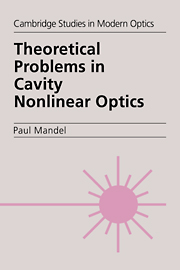Book contents
- Frontmatter
- Contents
- Introduction
- 1 Reduction of the Maxwell–Schrödinger equations
- 2 Parameter swept across a steady bifurcation I
- 3 Parameter swept across a steady bifurcation II
- 4 Optical bistability: Constant input
- 5 Optical bistability: Variable input
- 6 Multimode optical bistability
- 7 Free-running multimode lasers
- 8 Antiphase dynamics
- 9 Laser stability
- 10 Second harmonic generation
- 11 Saturable absorbers
- 12 Transverse effects in optical bistability
- Index
4 - Optical bistability: Constant input
Published online by Cambridge University Press: 16 October 2009
- Frontmatter
- Contents
- Introduction
- 1 Reduction of the Maxwell–Schrödinger equations
- 2 Parameter swept across a steady bifurcation I
- 3 Parameter swept across a steady bifurcation II
- 4 Optical bistability: Constant input
- 5 Optical bistability: Variable input
- 6 Multimode optical bistability
- 7 Free-running multimode lasers
- 8 Antiphase dynamics
- 9 Laser stability
- 10 Second harmonic generation
- 11 Saturable absorbers
- 12 Transverse effects in optical bistability
- Index
Summary
Introduction
Usage has reserved the expression optical bistability mostly for coherently driven passive systems. An atomic system is called passive when there is no population inversion. This is the case, for example, of a system at thermal equilibrium. On the contrary, the laser that we have described in Chapter 1 is a driven active system, because a population inversion is created. The laser equations we have studied so far describe an incoherently driven laser. However, nothing prevents driving a lasing cavity with a coherent field emitted by another laser. This is realized in a whole class of lasers that are used mainly as frequency converters. In optical bistability (OB), the driving field is usually a coherent field. Thus we have to account for two differences between the laser and the optically bistable system: (1) In OB, there is no inversion of population: 〈|A2|〉>〈|B2|〉, in the notation of Chapter 1. Hence, in the absence of interaction with a field, the population difference D relaxes toward a negative value. (2) The pumping is coherent, meaning that an external laser field is added to the cavity field.
Using the single-mode equations (1.48)–(1.50), we have to change the sign of D and Da (which amounts to keeping D defined in (1.34) as it is but changing P into –P and A into –A) and to add a source term in the equation for the complex field amplitude.
- Type
- Chapter
- Information
- Theoretical Problems in Cavity Nonlinear Optics , pp. 37 - 53Publisher: Cambridge University PressPrint publication year: 1997



